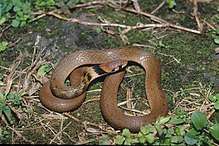Rhabdophis swinhonis
| Rhabdophis swinhonis | |
|---|---|
 | |
| Scientific classification | |
| Kingdom: | Animalia |
| Phylum: | Chordata |
| Class: | Reptilia |
| Order: | Squamata |
| Suborder: | Serpentes |
| Family: | Colubridae |
| Genus: | Rhabdophis |
| Species: | R. swinhonis |
| Binomial name | |
| Rhabdophis swinhonis (Günther, 1868) | |
| Synonyms | |
| |
Rhabdophis swinhonis is a keelback snake in the family Colubridae. It is endemic to Taiwan.[1][2] It is also known as Taiwan keelback[1][2] and Swinhoe's grass snake.[3][4] It is named for Robert Swinhoe, a British diplomat and naturalist stationed in China in mid-19th century[4] and who collected the holotype.[2]
Description
Rhabdophis swinhonis can reach a maximum length of 70 cm (28 in). It has 15–17 rows of keeled scales. The head is oval, the body is moderately stout, and the tail is moderately long. The medium to large eyes have dark grey-brown iris and round, jet black pupil surrounded by grey ring. The body is dorsally dark grey-brown with ill-defined or fairly prominent square areas of black. The underside is cream to light grey and is mottled with deposits of coarse dark pigment. The head is uniform dark olive grey to olive brown above, while the sides are lighter. There is an oblique black band below the eye as well as a larger black band on the side of head, above the corner of mouth. The nape bears a distinct, thick, and black backward-pointing chevron. The anal scale is divided and subcaudal scales are paired.[3]
Rhabdophis swinhonis is non-venomous and docile; when threatened it may expand its throat and neck transversely, but is unlikely to bite. It has nuchal glands that secrete a brown liquid; this may act as a predator deterrent, although its precise function remains unknown.[3]
Reproduction is through oviparity.[2] Each clutch contains 6–15 eggs.[3]
Habitat and distribution
Rhabdophis swinhonis occurs throughout Taiwan at elevations of 500–1,000 m (1,600–3,300 ft) above sea level. It is a diurnal snake that lives on the forest floor, bushlands, and other humid environments.[3] They also occur in agricultural fields.[1] The main prey are frogs.[1][3]
Conservation
Rhabdophis swinhonis is an uncommon species.[1][3] It is not facing significant threats, occurs in protected areas, and enjoys Class III protection.[1]
References
- 1 2 3 4 5 6 7 Lau, M. (2012). "Rhabdophis swinhonis". IUCN Red List of Threatened Species. IUCN. 2012: e.T192021A2029160. doi:10.2305/IUCN.UK.2012-1.RLTS.T192021A2029160.en. Retrieved 19 November 2017.
- 1 2 3 4 Rhabdophis swinhonis at the Reptarium.cz Reptile Database. Accessed 19 November 2017.
- 1 2 3 4 5 6 7 Hans Breuer & William Christopher Murphy (2009–2010). "Rhabdophis swinhonis". Snakes of Taiwan. Retrieved 19 November 2017.
- 1 2 Beolens, Bo; Watkins, Michael & Grayson, Michael (6 September 2011). The Eponym Dictionary of Reptiles. JHU Press. p. 258. ISBN 978-1-4214-0135-5.
